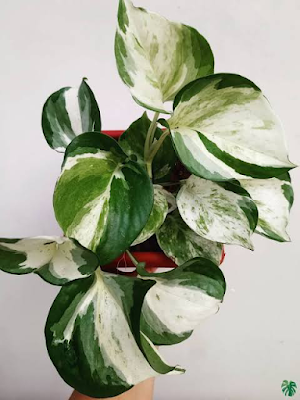Pothos or Money Plant
Pothos or money plant is a popular and versatile houseplant popular for its beautiful trailing vines and ease of care. While most types are primarily grown indoors, some can also thrive outdoors in warm and humid climates.
Why are pothos famous as money plant in India?
In India the pothos plant is commonly popular as the Money Plant due to its strong association with wealth and prosperity in traditional beliefs such as Feng Shui and Vaastu Shastra. Here are more reasons why it is famous in India.
Symbol of abundance and growth: The lush and vibrant appearance of the plant makes it a powerful symbol of abundance and growth. Its attractive foliage and trailing vines are often associated with prosperity and thriving conditions, further reinforcing its connection with wealth.
Auspicious heart-shaped leaves: The heart-shaped leaves of the plant are deemed highly auspicious, as they resemble coins. This visual similarity to money strengthens the belief that having a pothos plant will attract financial fortune and prosperity.
Positive energy, air-purifying qualities: Pothos is highly valued for its air-purifying qualities, making it a popular choice for indoor decorations. In addition to this, it is believed to bring positive energy and harmony to the surroundings, promoting a sense of well-being and prosperity.
Cultural and traditional beliefs: While the belief in pothos' money-attracting properties is widespread in India and other regions, it is essential to acknowledge that these beliefs are based on cultural and traditional practices rather than scientific evidence. Nevertheless, the popularity of pothos as a 'Money Plant' endures due to its positive symbolism and easycare nature. It's important to note that while pothos is a beautiful and popular houseplant, the belief in its money-attracting properties is based on cultural and traditional beliefs rather than scientific evidence. Nevertheless, pothos remains a cherished and widely loved plant in many Indian households and is admired for its lush foliage and easycare nature.
11 TYPES OF MONEY PLANTS:
1. GOLDEN POTHOS:
Botanical name: Epipremnum aureum
Itis one of the most common type, with heart-shaped green leaves streaked with golden-yellow variegation.
2. MARBLE QUEEN POTHOS
Botanical name: Epipremnum aureum 'Marble Queen'
Marble money plant features large, glossy leaves with green and white marbled variegation, making it a popular types choice.
3. JESSENIA POTHOS:
Botanical name: Epipremnum aureum 'Jessenia'
This variety displays deep green leaves with a hint of golden-yellow variegation, making it an intriguing types.
4. MANJULA POTHOS:
Botanical name: Epipremnum aureum 'Manjula'
A striking variety with green leaves that have silvery-white variegation and irregular edges, making it a unique money plant selection.
5. N'JOY POTHOS:
Botanical name: Epipremnum aureum N'Joy' Known for its small, heartshaped leaves with green centres and white edges, making it a delightful types to grow.
6. PEARLS AND JADE POTHOS:
Botanical name: Epipremnum aureum 'Pearls and Jade'
A unique variety with green leaves speckled with white and cream-coloured spots, adding interest to your different types of money plant collection.
7. SNOW QUEEN POTHOS:
Botanical name: Epipremnum pinnatum 'Snow Queen'
Features leaves with green centres and white-silver variegation, a wonderful types of money plant.
8. SILVER SATIN POTHOS:
Botanical name: Scindapsus pictus 'Satin Pothos'
Although not a true pothos, it is a similar trailing plant with heartshaped leaves featuring silver markings, a captivating types of money plant look-alike.
9. GOLDEN DRAGON POTHOS:
Botanical name: Epipremnum aureum 'Golden Dragon'
This variety displays green leaves with golden-yellow variegation, creating a dragon-scale pattern, a fascinating choice for a money plant enthusiast.
10. CEBU BLUE POTHOS:
Botanical name: Epipremnum pinnatum
A cultivar with green leaves and striking splashes of creamy-white variegation, adding charm to your unique types of money plant collection.
11. BLACK MONEY PLANT:
Botanical name: Epipremnum aureum
This is a popular indoor plant known for its striking dark green and silver variegated leaves. Its lush and resilient foliage adds a touch of elegance to interior spaces while requiring minimal care.
NOTE: Please note that some of these types of money plant in India may have various common names or be sold under different names by nurseries or retailers.
When growing pothos, it's essential to provide them with well-draining soil, indirect light, and regular watering to keep them healthy and thriving.






















